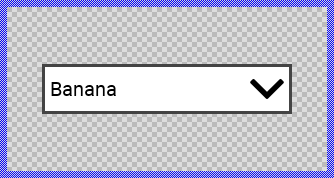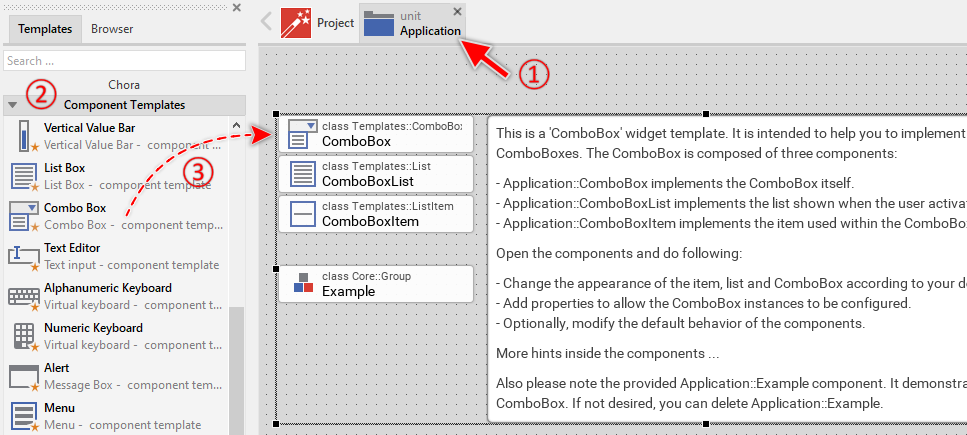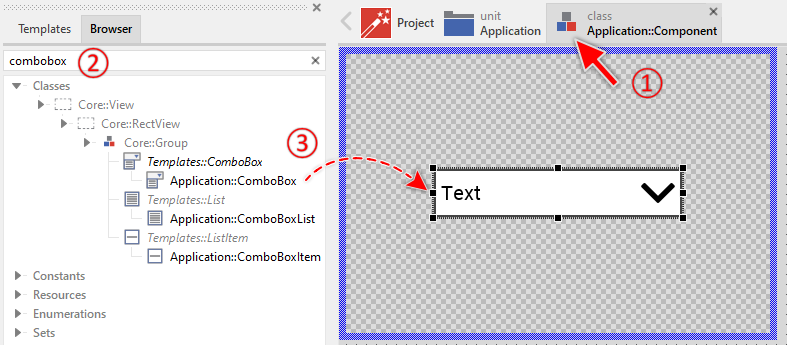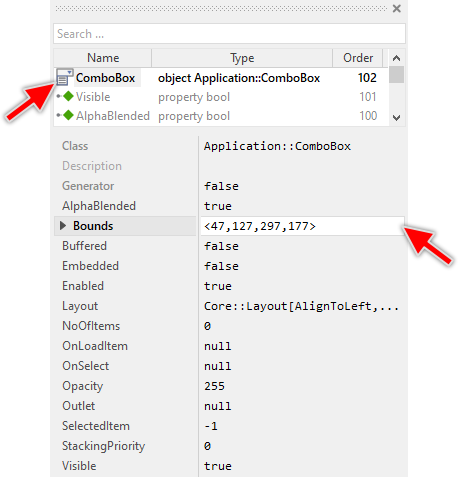Creating components from templates: Combo Box
With this template you can add a new Combo Box component to your project. Combo Box is a widget the user can interact with in order to select an option from a list of possible items. To display the available items the Combo Box implements a list and list item components. When the user selects an item within the Combo Box, the component sends signals to associated slot methods where your particular implementation is executed. If the Combo Box is focused the component can also be controlled by pressing keys on the keyboard or by using hardware buttons.
Components created with this template are intended to be adapted to your particular design expectations. After adding the new Combo Box you should edit the component, change its appearance and if desired also its behavior. Once you have adapted the component, you can embed instances of this Combo Box wherever you need in your GUI project. Because it serves as template, it is intentionally kept very simple. Nevertheless, Combo Boxs created by the template are working widgets. If desired, they can already be used as they are. The following figure demonstrates the default appearance of the Combo Box created by using the here described component template:

The approach with component templates has two functions. Primarily the templates should simplify the development of new components. Instead of creating the Combo Box from scratch you can use the available template. The second function is more educative. The template implements fully working Combo Box component you can investigate and learn about the corresponding programming aspects. The template is well documented. It contains annotations and inline comments with instructions helping you to understand how the component works and how it can be adapted to your particular needs.
This chapter provides an overview how the Combo Box component template is used within your own application and how you adapt this component according to your particular needs. You will find here also further details concerning the internal implementation of the Combo Box component.
Add new Combo Box component
To create a new Combo Box component from a template you simply Drag & Drop it between the Templates window and the Composer with an opened unit. This is important in that by using the component templates you add in fact a new class to your project. Classes, in turn, can exist within units only. The following are the typical steps to create a new Combo Box component from a template:
★First switch to the Composer page for the respective unit, where you want to add the new Combo Box component.
★Then ensure that the Templates window is visible.
★In Templates window switch to the folder Component Templates.
★In the folder locate the Combo Box template.
★Drag & Drop the template into the Composer window:

The Combo Box template is composed of multiple components: ComboBox, ComboBoxList, ComboBoxItem and Example. Here, the ComboBoxItem component implements the appearance and the behavior of a single combo box item. The ComboBoxList component implements a list where items are shown and the user can scroll and select them. The ComboBox component implements the combo box itself. It displays the actually selected item and presents the ComboBoxList component each time the user activates the combo box. Finally, the Example component implements a simple example demonstrating the usage of the combo box.
★If not needed, just select and delete the Example class.
★Eventually name the new added components ComboBox, ComboBoxList and ComboBoxItem.
The new created Combo Box component appears accompanied by annotation providing helpful tips how to proceed. If undesired, you can select and delete the annotation.
Use the Combo Box component
Once you have created the Combo Box component, you can use it to assemble more complex components. Technically seen, you embed an instance of the Combo Box class in-place within some superior GUI component. At the runtime, the superior GUI component takes care of the correct initialization and the displaying of all embedded components, so they appear similarly as you have composed them at the design time.
Step 1. Add new Combo Box instance
The following are the typical steps to create a new instance of an already existing Combo Box component:
★First switch to the Composer page for the respective GUI component, where you want to add the new Combo Box.
★Then ensure that the Browser window is visible.
★Within the Browser locate the class of the previously created Combo Box. This can be done easily with Browser's own filter function.
★Select the found class in the Browser window.
★Drag & Drop the selected class into the Composer area.

★Eventually name the new instance according to its function within the GUI component (e.g. Options).
Component templates are intended to create widgets which can be modified and adapted to your particular design expectations. In the following sections you will learn how to do this. Originally, if not yet modified, the Combo Box appears as a white rectangle surrounded by a border. The combo box items are displayed as text. Our intention is to keep the component templates as minimalistic as possible so they don't distract you with less important design details. The arrow image at the right edge of the combo box indicates that it can be activated to display a drop down list with corresponding items.
Step 2. Inspect the Combo Box instance
As long as the Combo Box is selected you can inspect and modify its properties conveniently in the Inspector window as demonstrated with the property Bounds in the screenshot below. This is in so far worth mentioning as diverse features of the Combo Box are controlled by the corresponding properties. If you are not familiar with the concept of a property and the usage of Inspector window, please read first the preceding chapter Compositing component appearance.

The Combo Box component descends from the Mosaic class Core::Group. Consequently, most of the properties listed in the above screenshot are inherited from this base class. Particular to the Combo Box are only few following properties:
Property |
Description |
|---|---|
NoOfItems |
The property NoOfItems stores how many items are currently managed within the ComboBox. This value should correspond to the number of options the ComboBox offers to the user. |
OnLoadItem |
The property OnLoadItem should refer to a slot method, which will be invoked by the ComboBox in order to load an item with its corresponding content. Within the slot method the affected item can be accessed and initialized via variable View. |
OnSelect |
The property OnSelect can refer to a slot method, which will receive a signal each time the user has selected an item within the ComboBox. Thereupon the method's logic will be executed. In the associated slot method you can evaluate SelectedItem property to estimate which item has been selected. |
Outlet |
The property Outlet can refer to any other int32 property the widget should remain synchronized with. When the user selects an item, the affected property is automatically updated to reflect the item's number. On the other hand, when the referred property is modified by another component, the ComboBox is automatically notified to remain in sync with the property. This approach follows the Model-View-Controller (MVC) programming paradigm. Here the ComboBox represents the view and controller. The property referred via Outlet can be seen as a part of the model. See also Outlet properties. |
SelectedItem |
The property SelectedItem stores the index of the currently selected item or -1 if no item is selected. The first item has the index 0, the second 1, and so far. |
Step 3. Arrange the Combo Box within the superior component
Once added to the component, you can freely move the Combo Box instance, or you simply grab one of its corners and resize it in this way. You can control the position and the size of the component also by directly modifying its property Bounds. If you want the Combo Box to appear behind other views you can reorder it explicitly.
IMPORTANT
Please note, this document is actually UNDER CONSTRUCTION. It is incomplete. We are working on it ...
